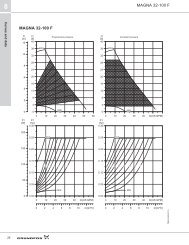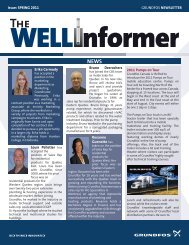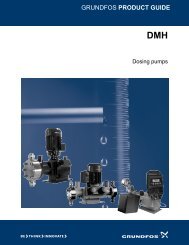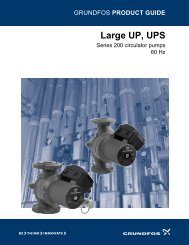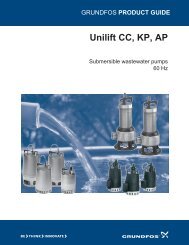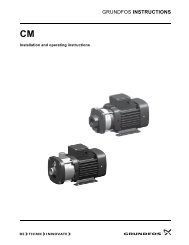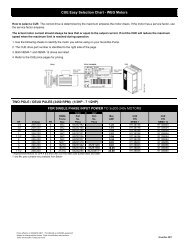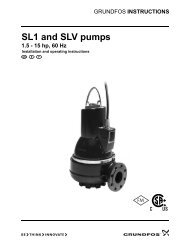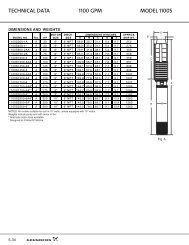Create successful ePaper yourself
Turn your PDF publications into a flip-book with our unique Google optimized e-Paper software.
<strong>Grundfos</strong> E-<strong>pumps</strong><br />
9<br />
9. Frequency-controlled operation<br />
Variable frequency drive, function<br />
and design<br />
Variable frequency drive (VFD)<br />
Speed control of <strong>pumps</strong> involves a variable frequency<br />
drive. So it will be relevant to have a closer look at<br />
what a variable frequency drive is, how it operates and<br />
finally to discuss related precautions involved in using<br />
a variable frequency drive.<br />
Basic function and characteristics<br />
It is a well-known fact that the speed of an<br />
asynchronous motor depends primarily on the number<br />
of poles and the frequency of the supply voltage. The<br />
amplitude of the voltage supplied and the load on the<br />
motor shaft also influence the motor speed, however,<br />
not to the same degree. Consequently, changing the<br />
frequency of the supply voltage is an ideal method for<br />
asynchronous motor speed control. In order to ensure<br />
a correct motor magnetization, it is also necessary to<br />
change the amplitude of the voltage.<br />
MT<br />
Fig. 70 Displacement of motor torque characteristic<br />
A frequency/voltage control results in a displacement<br />
of the torque characteristic whereby the speed is<br />
changed. Figure 70 shows the motor torque<br />
characteristic (T) as a function of the speed (n) at two<br />
different frequencies/voltages. In the same diagram is<br />
also drawn the load characteristic of the pump. As it<br />
appears from the figure, the speed is changed by<br />
changing the frequency/voltage of the motor. The<br />
variable frequency drive changes frequency and<br />
voltage, so therefore we can conclude that the basic<br />
task of a variable frequency drive is to change the<br />
fixed supply voltage/frequency, for instance 3 x 480 V,<br />
60 Hz, into a variable voltage/frequency.<br />
f 2<br />
f 1<br />
f >f 1 2<br />
n<br />
TM00 8876 3396<br />
Components of the variable frequency<br />
drive<br />
In principle, all variable frequency drives consist of the<br />
same functional blocks. As mentioned previously, the<br />
basic function is to convert the supply voltage into a<br />
new AC voltage with another frequency and amplitude.<br />
First, variable frequency rectifies the incoming supply<br />
voltage and stores the energy in an intermediate circuit<br />
consisting of a capacitor. The resulting DC voltage is<br />
then converted to a new AC voltage with another<br />
frequency and amplitude.<br />
Because of the intermediate circuit in the variable<br />
frequency drive, the frequency of the supply voltage<br />
has no direct influence on the output frequency and<br />
thus on the motor speed. It does not matter whether<br />
the frequency is 50 or 60 Hz as the rectifier can handle<br />
both. Additionally, the incoming frequency will not<br />
influence the output frequency, as this is defined by the<br />
voltage/frequency pattern which is defined in the<br />
inverter. Keeping the above mentioned facts in mind,<br />
using a variable frequency drive in connection with<br />
asynchronous motors provides the following benefits:<br />
• The system can be used in both 50 and 60 Hz areas<br />
without any modifications.<br />
• The output frequency of the variable frequency drive<br />
is independent of the incoming frequency.<br />
• The variable frequency drive can supply output<br />
frequencies which are higher than power supply<br />
frequency which makes oversynchronous operation<br />
possible.<br />
Power Mains supply AC AC<br />
EMC<br />
EMC filter<br />
filter<br />
Rectifier<br />
Rectifier<br />
Interme-<br />
Intermediate<br />
circuit<br />
DC<br />
Control circuit<br />
Inverter<br />
Inverter<br />
Fig. 71 The main blocks of a variable frequency drive<br />
TM03 0432 5104<br />
Frequency-controlled operation<br />
61



